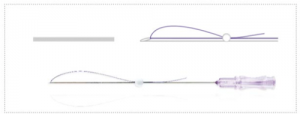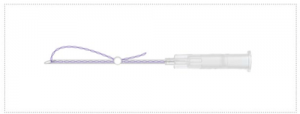Thread Lift
Thread lift is a type of procedure wherein threads are used to produce skin tightening and lifting. In thread lifts, the threads are placed in the skin tissue or just beneath the skin without the need of surgery. There are different types of thread lifting, each comes with different techniques and results. In recent years, the PDO thread lift has become the most popular choice. The threads are made of PDO (polydioxanone), a safe biomedical material that is also used as surgical sutures. There are various forms of PDO threads, e.g., monofilament, braided, twined thread, barbed, or bi-directional cogged threads. Each of these threads comes with different lengths and thicknesses. Some of the threads may come with names like tornado, double screw, feather thread, etc. even though they are the same threads mentioned above. The selection of which type of thread to use depends on the treatment areas, the aesthetic purpose of the treatment and the severity of the skin laxity.
After the threads are placed in the target areas, they produce an immediate lifting due to the physical pulling effect. PDO threads also produce delayed effects which stimulate collagen production, neovascularization, and tissue regeneration. These delayed effects will begin a few weeks after the threads are inserted and these delayed effects are responsible for the prolonged skin tightening and lifting results. After insertion, the PDO threads undergo complete reabsorption in the body in about six months. However, the delayed effects of collagen production, neovascularisation and tissue regeneration will ensure the actual skin tightening and lifting will last much longer to about 2 years.
PDO thread lifting does not require an incision, and thus there are no external wounds and scars. The procedure is effective to treat mild to moderate cases of skin laxity in the face. Compared to surgical procedures, the downtime and recovery of PDO thread lifting are very short.
Applications of PDO Threads
-
-
-
Midface: lifting of the cheek and reduce the nasolabial folds and marionette lines.
-
Jawline: lifting and slimming the jawline.
-
Chin: to reduce double chin.
-
Neck: tightening of the neck skin and reduce neck wrinkles.
-
Eyebag: tightening of eyebag skin and reduce eyebag wrinkles.
-
Crowfeet: reduce wrinkles at the outer corner of the eye
-
Brow: lifting of the brow
-
-
 |
| Monofilament Thread |
 |
| Twined Thread |
 |
| Bi-directional Cogged Thread |
Preparation
-
-
-
Inform the doctor of any pre-existing medical conditions and drug allergy. All medical conditions must be treated and stabilized before the procedure.
-
Stop smoking at least one week before the procedure. Smoking may diminish the results of PDO thread lifting.
-
Stop the following medications and supplements one week before the procedure:
-
All supplements containing vitamin E, ginseng, ginkgo, garlic, fish oil, and other ingredients increase bleeding during the procedure. Other supplements, traditional medicine, and herbs, in which elements are unknown, have to stop as well.
-
Medicine that increases bleeding during the procedure such as aspirin, NSAIDs, and warfarin. However, you may need to consult your physician who prescribed the medication before you stop them.
-
-
-
Procedure
Duration: 20-60 min
Anaesthesia: Numbing cream and cold compression
Downtime: 1-3 days
How long results last: 1 to 2 years
Technique: PDO threads are inserted under the skin using blunt tip needles to avoid injuring blood vessels. The types and number of threads used vary, depending on the target areas, aesthetic goals, and severity of the condition.
Post Treatment Care**
-
-
-
What to expect:
-
Mild swelling for 3-5 days. Bruises are possible but are rare.
-
The treated area may feel tight for 1-2 weeks.
-
-
Avoid putting pressure on the treated area for one week. Sleep on the back the avoid pressure on the face. No facial massage for at least 2 weeks.
-
Avoid excessive movement of the face, such as open the mouth widely and laugh excessively for 3-5 days.
-
-
**The instructions in this list are only for general guidance and the list is not meant to be exhaustive. If you have any specific queries or concerns during the post-operative recovery, please contact the clinic for further advice.





